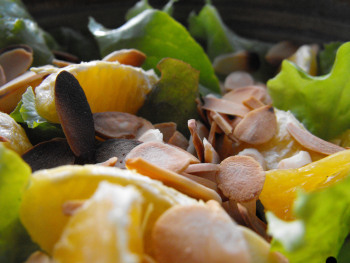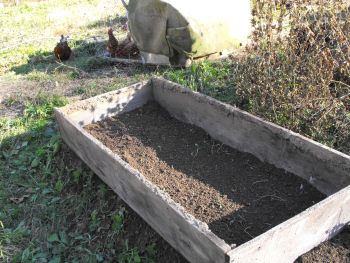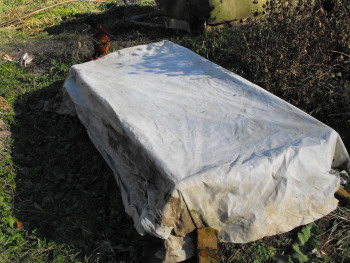
How to plant a lettuce bed
Lettuce was the first
vegetable I learned to grow, and it's still one of my favorites.
I
tried a bunch of different growing methods then meandered my way back
to the same method my father taught me to start with. My method
will take you about an hour the first time you build the cold frame
and, if you have some old boards lying around your barn, will cost
about about fifty cents in screws and seeds. After the first
time, planting will take ten minutes or less.
Timing:
Lettuce is picky about moisture and heat. If you don't have
enough of one and if you have too much of the other, you'll end up with
bitter lettuce. (I tried to grow Batavian lettuce, which does wait longer before it bolts,
but it still got bitter in the summer.) I recommend planning your
planting dates to avoid bitter lettuce season.

Here on the border of zones 5 and 6, I plant my lettuce as follows:
- February 4 (cold frame)
- March 4 (cold frame)
- April 4 (no cold frame)
- Take a break --- summer's not lettuce time!
- September 9 (no cold frame)
- October 19 (cold frame)
Notice that I plant a
new set of lettuce about every month --- I grow leaf lettuce and like
to eat it at the delicious baby lettuce stage, then pull it up once the
first hint of bitterness comes in. (I often let the April
planting self-seed, which means I don't have to do any actual planting
for the September "planting.")
You can find
out what your zone is here and adjust your planting dates
accordingly.
Cold Frame:
 If you want to extend your harvest into the
winter, you'll need to build a simple cold frame. I tried a lot
of complicated cold frames, then came to the conclusion that the
simplest one was the best all along. To make your cold frame,
measure the size of your permanent
bed and cut 2X10 boards to the appropriate length --- two for the
length and two for the width. I like to use a miter saw because
it has a safety guard and keeps my fingers well clear of the blade, but
you can cut your boards with a hand saw or a table saw if you'd
rather.
If you want to extend your harvest into the
winter, you'll need to build a simple cold frame. I tried a lot
of complicated cold frames, then came to the conclusion that the
simplest one was the best all along. To make your cold frame,
measure the size of your permanent
bed and cut 2X10 boards to the appropriate length --- two for the
length and two for the width. I like to use a miter saw because
it has a safety guard and keeps my fingers well clear of the blade, but
you can cut your boards with a hand saw or a table saw if you'd
rather.
Then simply screw the boards together to make a box. You'll find
it simplest to pre-drill the holes (three per edge), then screw in
three inch screws. Much swearing is bypassed if you do this with
a friend....
You can also brace the corners, which will make it easier when you move
the cold frame. But I tend to go for the simplest possible method
because I want my lettuce to go in the ground now. The bed above is on its
third season, is made out of half-rotten barn wood, and has been moved
twice...and I think it'll last at least three more seasons. All
for about a quarter's worth of screws.
Planting
and Covering:
If you've got a good
permanent bed, you'll just need to pull out a few weeds and rake the
ground in preparation for planting. If working on new ground,
though, you'll want to till the ground well first. Either way,
after raking, I sprinkle lettuce seed liberally (about 5 seeds per
inch) over the ground. I choose to buy cheap lettuce seed in bulk
from
the feed store where it costs about $3 per cup. (Yes, we're
talking about a baking-sized measuring cup.) That cup of seed
will last me
a year or two of lettuce beds. I've also bought fancy mesclun
mixes, but haven't found them to be all that much tastier and the price
just isn't right.
 If you're planting in the late spring or late
summer without a cold frame, you're done! Otherwise, you'll want
to cover your bed with some sort of row cover fabric. I got my
row cover for free using the catalog coupon from Gardens Alive, and now
three seasons later they're just about ready to be replaced.
If you're planting in the late spring or late
summer without a cold frame, you're done! Otherwise, you'll want
to cover your bed with some sort of row cover fabric. I got my
row cover for free using the catalog coupon from Gardens Alive, and now
three seasons later they're just about ready to be replaced.
I've tried a bunch of different cold frame covers and have settled on
simply weighing the row cover down with a few rocks. Using
windows as the cover is problematic because the lettuce bed can get too
hot during sunny days and I'm incapable of remembering to water plants
which are outdoors during a rainy season. Mark and I once built a
fancy screen-door type cover for a cold frame out of furring strips
with row cover fabric
stapled on top, but it was a pain to open up so I didn't eat much of
the lettuce. Simple is always best.
Harvest:
 Then you wait a few weeks, but not very
long. I start eating my lettuce when it's just an inch and a half
tall. I use scissors to cut off the tops of the plants like I'm
giving the lettuce bed a haircut, being careful to leave about half an
inch at the base of the plant uncut. You might need to pull out a
few weeds, but you should have planted the lettuce close enough
together that it shades out most of the weeds.
Then you wait a few weeks, but not very
long. I start eating my lettuce when it's just an inch and a half
tall. I use scissors to cut off the tops of the plants like I'm
giving the lettuce bed a haircut, being careful to leave about half an
inch at the base of the plant uncut. You might need to pull out a
few weeds, but you should have planted the lettuce close enough
together that it shades out most of the weeds.
In warm weather, I cut half of the lettuce in a 4X8 foot bed every day
and the lettuce grow fast enough that I can alternate from half to
half and eat salad almost every day. In colder weather, the same
bed may only feed us lettuce two times a week.
Don't forget to check out our recipe page giving you ideas for in-season
salads! And don't let the length of this page scare you off
--- once you learn to plant lettuce you'll realize it's the easiest
vegetable to grow, and far tastier than store bought.
Want more in-depth information? Browse through our books.
Or explore more posts by date or by subject.
About us: Anna Hess and Mark Hamilton spent over a decade living self-sufficiently in the mountains of Virginia before moving north to start over from scratch in the foothills of Ohio. They've experimented with permaculture, no-till gardening, trailersteading, home-based microbusinesses and much more, writing about their adventures in both blogs and books.
Want to be notified when new comments are posted on this page? Click on the RSS button after you add a comment to subscribe to the comment feed, or simply check the box beside "email replies to me" while writing your comment.

Love your trial and error stories! I have the green thumb this year and it has taken over my hobbies, as thge best! thanks joe
As a newbie green thumb lady, I appreciate all your information. Keep posting please! Best energies!
Amanda --- There are a few tricks with snow. First is to put up your frost protection before the snow comes! Here in zone 6, we get freeze/thaw cycles all winter, so it's not usually relevant to us, but I also am generally planting into quick hoops that went up in the fall.
Here in zone 6, we get freeze/thaw cycles all winter, so it's not usually relevant to us, but I also am generally planting into quick hoops that went up in the fall.
Yep, I wrote "quick hoops" instead of "cold frames" --- we've transferred over since I wrote this post in 2008 and think quick hoops are especially useful in snowy climates.
As for knowing when conditions are right for planting --- it's all about soil temperature. Good luck!